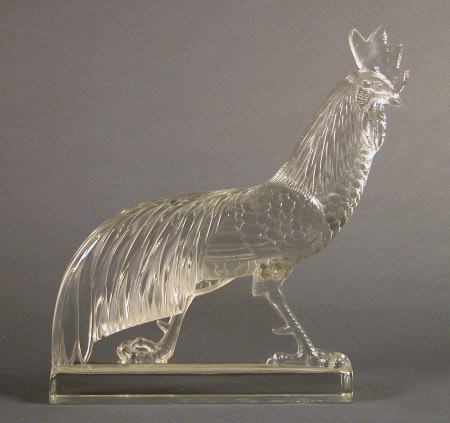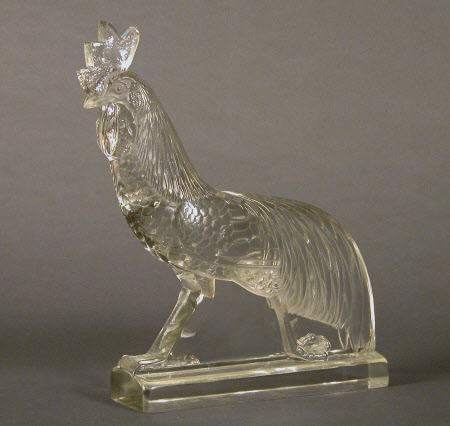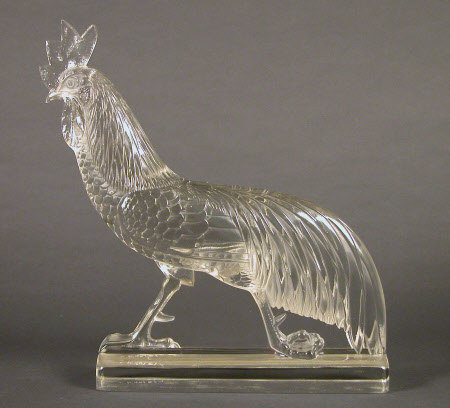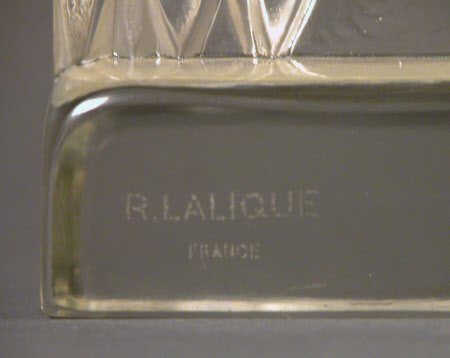Coq Gaulois de Jungle
René Lalique (Ay 1860 - Paris 1945).
Category
Glass
Date
1936 - 1939
Materials
Glass
Measurements
395 x 345 x 90 mm
Place of origin
Paris
Order this imageCollection
Chartwell, Kent
NT 1101819
Caption
This strutting cockerel, made by the celebrated French glass artist, René Lalique, was a gift from General Charles De Gaulle to Lady Churchill. Lalique was a pioneering and versatile designer, who made his name in fin-de-siècle Paris with his Art Nouveau jewelry inspired by fluid, natural forms. In the 1920s, he successfully adapted to the decidedly different geometric style of Art Deco, capturing all the glamour of the Jazz Age in his spectacular glass fittings for luxury ocean liners and streamlined car mascots. This cockerel is an example of his later work and as the emblem of France was an apposite choice of present. In 1940 De Gaulle was under-secretary for national defence for the French government, but following Marshal Pétain’s surrender to the Germans, he fled to London. Upon his arrival, De Gaulle became leader of the Free French Forces which received considerable support and funding from the British government. On 18 June 1940 he made a BBC radio broadcast to the French people, calling upon them to join him in the fight against Nazism. Sir Winston Churchill fully supported De Gaulle and his work in London, although their relationship throughout the rest of the war could be fiery and at several points came close to breaking point. Despite this, Churchill continued to regard De Gaulle as the saviour of France and De Gaulle never forgot Churchill’s support. The homonymy of the Latin word gallus (cockerel) and Gallus (inhabitant of Gaul) has made the bird a potent symbol in French culture since the middle ages. One can imagine that De Gaulle – whose very name summons Gallic pride – saw something of himself in this animal that is prized for its strength, valour and determination when protecting the flock.
Summary
Sculptural model, clear glass, moulded and frosted, in the form of a cockerel. Factory model number 1224 'Coq de jungle' designed in 1936 by René Lalique for the Lalique glass factory, Bas-Rhin (Wingen-sur-Moder), France. Made sometime between1936-39. Acid etched signature 'R. Lalique, France'.
Full description
Sculptural model, clear glass, moulded and frosted, in the form of a cockerel. Factory model number 1224 'Coq de jungle' designed in 1936 by René Lalique for the Lalique glass factory, Bas-Rhin (Wingen-sur-Moder), France. Made sometime between1936-39. Acid etched signature 'R. Lalique, France'. This crystal glass cockerel made by René Lalique can be seen in Chartwell’s drawing room, and was a gift from General Charles De Gaulle to Lady Churchill. De Gaulle was Under-Secretary for National Defence for the French Government before he left France for London on 16 June 1940 following the newly appointed French Prime Minister, Marshal Pétain’s surrender to the Germans. Following his arrival in London De Gaulle became Leader of the Free French Forces, a movement which received considerable support and funding from the British Government. On 18 June 1940 De Gaulle made a radio broadcast from London to the French people stating, “I say honour, for France has undertaken not to lay down arms save in agreement with her allies. As long as the allies continue the war, her government has no right to surrender to the enemy … It is therefore necessary to group the largest possible French force wherever this can be done. Everything which can be collected by way of French military elements and potentialities for armaments production must be organised wherever such elements exist. I, General de Gaulle, am undertaking this national task here in England. I call upon all French servicemen of the land, sea, and air forces; I call upon French engineers and skilled armaments workers who are on British soil, or have the means of getting here, to come and join me. I call upon the leaders, together with all soldiers, sailors, and airmen of the French land, sea, and air forces, wherever they may now be, to get in touch with me. I call upon all Frenchmen who want to remain free to listen to my voice and follow me. Long live free France in honour and independence!” Sir Winston Churchill fully supported De Gaulle and his work with the Free French Forces, however their relationship throughout the rest of the war could be fiery, and at several points came close to breaking point. Despite this, Churchill continued regard De Gaulle as the saviour of France and De Gaulle never forgot Churchill’s support.
Marks and inscriptions
acid etched signature R. Lalique, France
Makers and roles
René Lalique (Ay 1860 - Paris 1945)., artist




